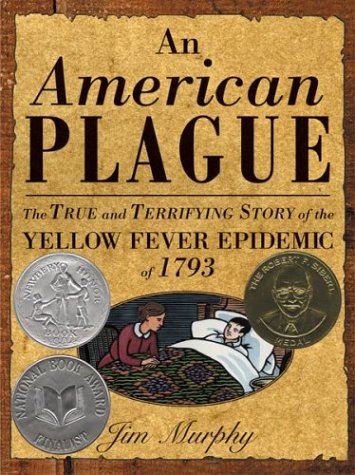 |
 |
 |
 |
 |
 |
 |
 |
 |
 |
 |
 |
 |
 |
 |
 |
 |
 |
 |
 |
 |
 |
 |
 |
 |
 |
 |
 |
 |
 |
 |
|
|
 |
|
|
|
 |
|
|
|
Young Adult Book Project |
|
|
|
|
|
|
|
|
|
 |
|
|
|
Justification for Use in the Secondary Classroom |
|
|
 |
|
|
|
|
|
|
I think this book has a lot of features that will appeal to high school students. For example, the scenario of the disease epidemic is something the students should find compelling, what with our modern fears of West Nile Virus, anthrax, smallpox, bioweapons, and so forth. Students can consider the nature of an individual's experience with a widespread disaster and can discuss disaster preparedness and the political dimensions of an epidemic. Also, as one reviewer pointed out, the engrossing, edge-of-your-seat pacing should help draw students into a world (colonial America) that they might not otherwise be interested in exploring.
This book, purported to be based closely on recorded historical facts, will also provide an opportunity to discuss the problems of writing "true" stories: How is "history" perceived by those who live through it, how does it come to be written down and preserved, and how is it perceived again through those writings? How can a writer's biases |
|
|
|
|
influence his portrayal of a historical event? Where does the history stop and the fiction begin (if such a thing can be determined)? A small number of secondary sources (current scholarship on how history is constructed, etc.) could be introduced to enrich this discussion. Some examination of other historical accounts of this event could provide some context and diversity of perspective.
We can also compare the book to works actually authored in the late 18th century and discuss in what ways this modern author imitated the writing style of that time period and used facsimile reproductions of contemporary newspapers in order to create the "mood" of 1790's Philadelphia.
Each of these possible approaches will help the students develop valuable skills they can apply in their future literature and history studies. They will also develop critical thinking skills as well as a willingness to question the authority of written works. |
|
|
|
 |
|
|
|
Web Sites |
|
|
|
has excellent ideas for activities, including having students look for newspaper articles on modern diseases we don't know enough about (as was the case with the yellow fever in 1793) and having students consider the account of the Free African Society in context of the historical, social, economic and political dimensions of race relations in 1793. Included are numerous, extremely useful websites that may be used to develop activities and for student research.
Carnegie Mellon U. History Course: This college history course, entitled "Disaster! Fires, Plagues, Hurricanes and Floods in American History" has a very up-to-the-minute emphasis on examining the degree to which natural disasters may actually be preventable or at least mitigated, and how people may experience the natural disaster differently depending on their race, class, ethnicity, or gender. Thoughtful discussion questions are included on this syllabus. |
|
|
|
|
National Science Teachers Association: The NSTA recommends that students use the book's extensive endnotes for research. The book may be used as a supplement in a biology classroom, and students can use it to begin discussing issues such as the process of science, the controversy among doctors regarding diagnosis and treatment of a disease, the appropriate care of patients, and more. As a winner of one of the NTSA's 2004 Outstanding Science Trade Books awards, this book comes highly recommended for classroom use.
ENC (Eisenhower National Clearinghouse) Online: This site enthusiastically recommends using this book as a tool for multidisciplinary study: "what better way to interest students in history than to demonstrate the link between epidemics and historical events?" This site |
|
|
|
|
|
|
 |
|
|
|
Back to Young Adult Book Project Main Page |
|
|
|
Home |
|
|
|
READ 5326 Home |
|
|
|


